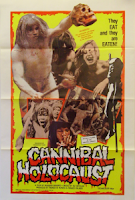Cannibal Holocaust (1980)
 A group of famous documentarians, known for bringing back extremely violent footage from their projects, has gone missing in the Amazon rain forest. They intended to go deep in the jungle and film the rituals of tribes untouched by the modern world, many of whom are still known to practice cannibalism.
A group of famous documentarians, known for bringing back extremely violent footage from their projects, has gone missing in the Amazon rain forest. They intended to go deep in the jungle and film the rituals of tribes untouched by the modern world, many of whom are still known to practice cannibalism.Seeking a ratings bonanza, a New York entertainment agency hires Harold Monroe (Robert Kerman) to find out what happened to them and bring them back alive if possible - and, if not, retrieve the footage.
Arriving at a military outpost, Monroe enters the jungle with his guide Chaco (Salvatore Basile) and Chaco's aid Miguel, dragging the captured son of a shaman of the Yacumo tribe along as leverage. The boy was captured after a military raid after he and others from the tribe were seen engaging in ritual cannibalism in an attempt to rid the jungle of the spirits of the film crew. The Yacumo are not in the mood to deal with white people at the moment because of something the missing documentarians apparently did.
It turns out the missing crew also stirred up something between the warring Yanomamo and Shamatari tribes deeper in the jungle. After rescuing a small group of Yanomamo from a Shamatari attack, they are led back to the village and, although treated with suspicion in the beginning, slowly gain the tribe's trust enough to get back the missing footage, although the crew has been dead for sometime - their bones form a shrine that has been erected to try and appease their spirits.
Back in New York Monroe works with the television executives to assemble the footage for a planned television special. He is shocked by what he sees, which is largely a disdain by the film makers for the life and safety of the tribes. Turns out the leader of the crew, Alan Yates (Carl Gabriel Yorke), is already well-known for staging atrocities in war-torn areas such as Uganda and Cambodia, and they do the same thing in the Amazon, terrorizing the Yacumo tribe by burning down part of their village and having sex with his girlfriend Faye (Francesca Ciardi) among the ashes.
The other members of the crew, Mark (Luca Barbareschi) and Jack (Perry Pirkanen) are no better, participating with Alan in the gang rape of a young Yanomamo girl, which results in the tribe killing her and impaling her upon a pole. They aren't done, however. The entire crew quickly gets their comeuppance.
This is one of those movies that has a reputation even among those that haven't seen it. First, there are real scenes of animal deaths in the film. Typically, I don't have a problem with this; I am a devout carnivore, and I am not squeamish when it comes to knowing where my food comes from. However, I am for the animal being treated as humane as possible until it is slaughtered. There were similar scenes in The Man from Deep River, another Italian film dealing with natives (this time in northern Thailand) with some cannibal themes, but most of the killings in that movie are strictly in a documentary style. Same here in most cases; this, in fact, isn't the only movie of the time to kill live snakes. The cobra killed in Sssss! is a major example.
My problem was with two scenes. The turtle was beheaded before being dismembered, but the way the crew played around with its head was a complete disgrace. At least it got eaten. Same can't be said for the pig - it may have been eaten off screen, but kicking it and being brutal towards it before shooting it was uncalled for.
I know that this was done to make a point about what the people making the documentary were like, and how they had no real respect for the rain forest or anyone or anything living in it. To the real actors' credit this was quite shocking for them to film, and though director Ruggero Deodato was going for realism, it is obvious he could have done it differently - a fact that, all these years later, he grudgingly admits.
Despite the killings being the most known part of the movie (other than the fact Deodato and producer Francesco Palaggi were put on trial for the cast's murder, forcing them to produce them ahead of schedule to prove they were still alive), I found one scene more disturbing than all the others, and that was the treatment of the adultress (Lucia Constantini). Even knowing it was fake did not make it any easier to watch.
That is largely a point of the film. It is not supposed to be easy to watch, and it doesn't feel like it was made to be usual exploitation fare. It does have a message about exploiting native cultures, although the "native rituals" in the film are largely bullshit, and about whether civilized man is really civilized. It's just this message is handled so clumsily that too many people focused on parts of the film rather than the film itself.
On the positive side, most of the acting is well done. Most of the practical effects are realistic, the location filming is well done, Deodato is above-average for a low-budget '70s Italian director and there is plenty of great cinematography. It is worth seeing, but typically on your own unless you know the taste of the crowd you're seeing it with.
Cannibal Holocaust (1980)
Duration: 96 minutes
Starring: Robert Kerman, Carl Gabriel Yorke, Francesca Ciardi
Director: Ruggero Deodato



Comments
Post a Comment